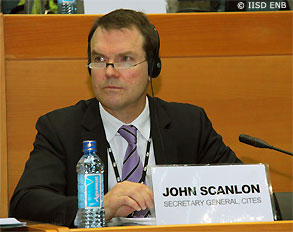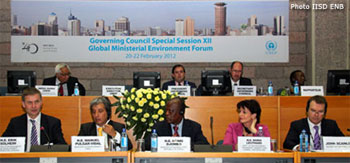UNEP Governing Council and Global Ministerial Environment Forum (GMEF)
GMEF Plenary Panel on the Institutional Framework for Sustainable Development
12th Special Session
21 February 2012, Nairobi, Kenya
Panel Chair, Minister Solheim, Honorable Ministers, and distinguished delegates.
It is a great honour to be able to share some thoughts with you on this very important topic and to offer you a perspective from a multilateral environment agreement (MEA) secretariat.

- "We should think of synergies beyond the perspective of
administrative synergies, and include programmatic, financing
and system-wide synergies in our discourse - as this is where
substantial benefits lie in enhancing national level
implementation" , CITES Secretary-General, John E. Scanlon
Firstly, a little about the Convention on International Trade in Endangered Species of Wild Fauna and Flora (CITES), which is the Convention I represent.
CITES sits at the intersection of trade, environment and development.
It regulates international trade in close to 35,000 species of plants and animals – with international commercial trade generally prohibited for 3% of these species, and with international commercial trade for the remaining 97% regulated to ensure the trade is legal, sustainable and traceable.
CITES has been at the cutting edge of the debate on the sustainable use of biodiversity for the past 36 years and it has records of over 11,000,000 international trade transactions in its data-bases for that period – trade which on many occasions has benefitted local communities, such as with the vicuña in South America.
We are also confronting a serious challenge with illegal trade that some estimate to be worth between USD 5 billion and USD 20 billion per year – illegal activity that is driving many species towards extinction, and depriving local people of development choices and governments of potential revenue.
Against this backdrop, our obsession is how we can best support States in their efforts to implement the Convention at the national level.
The ‘zero draft’ outcome document for the United Nations (UN) Conference on Sustainable Development, or Rio+20, makes reference to two options for strengthening the environmental dimension of sustainable development – briefly put, to create a specialized agency for the environment or to strengthen the capacity of UNEP, including through universal membership (see paragraphs 50, 51, 51 alt and 52).
I do not propose to address either of these options; rather I will address another element of environmental governance that is referenced in the zero draft, namely enhanced coordination and cooperation amongst conventions, which some often refer to as synergies (see paragraph 55).
Synergies amongst conventions is often approached from the perspective of synergies amongst the various secretariats that service the conventions, which appears to be the focus of the zero draft outcome document.
Addressing administrative synergies is fine but the issue of synergies would benefit from being addressed from a much wider perspective – one that includes programmatic synergies, financing synergies and synergies within the UN-system and beyond.
Administrative synergies are sometimes promoted as a means of finding savings to redirect towards implementation. This is a sound objective, but if we look at the biodiversity cluster of conventions any possible savings would likely be in the order of one or two million dollars, which will not go far in enhancing implementation efforts.
In looking at synergies between conventions as a means of achieving savings, which we clearly must do, we also need to look at the role of UNEP and our service providers.
UNEP no longer services all of its own administrative needs. For the past 15 years or so it has been serviced by the UN Office at Nairobi (UNON). It is, in essence, a UNON administered Programme. Yet UNEP continues to administer certain convention secretariats, including the CITES Secretariat. UNEP is, in many instances, playing a role that is akin to a ‘middle man’ between the convention secretariat(s) and the service provider(s), which comes at a cost.
UNEP’s comparative advantage is not in providing administrative services and perhaps too much emphasis has been placed on this aspect of UNEP’s relationship with conventions, distracting attention from where UNEP is needed most and performs best – on programme, financing and UN system-wide support.
Maybe it is time to consider liberating UNEP from the role of administering convention secretariats and to have them directly administered by the actual service providers, namely UNON and/or the UN Office at Geneva (UNOG) - thereby allowing UNEP to focus on where it has a comparative advantage, namely with programme, financing and UN system-wide synergies.
Interestingly, the convention that perhaps benefits most from UNEP programmatically, the UN Framework Convention on Climate Change, is not administered by UNEP.
UNEP could play (and in some cases is playing) a key role in supporting the implementation of conventions at the regional and national levels. For example, most conventions only have a global secretariat presence. As such they are unable to participate in the national level UN Development Assistance Framework (UNDAF) process, the UN’s principal vehicle for ‘delivering as one’ at the country level. UNEP could help bring the conventions’ perspective to the development of the UNDAF, as is anticipated by the UN Development Group Environmental Sustainability Guidelines.
UNEP can also assist conventions with, for example:
- enhancing linkages to regional processes through its regional offices;
- assisting with access to funding through the Global Environment Facility (GEF);
- involving the various convention focal points at the national level in the revision of National Biodiversity Strategy Action Plans (NBSAPs);
- facilitating shared knowledge management in promoting one coherent body of international environmental law, such as through InforMEA - a joint initiative of UNEP (DELC) and 13 MEA secretariats;
- incorporating convention implementation into global capacity-building programmes, such as the excellent work UNEP did with the judiciary; and
- linking the science required to implement conventions to the capacity-building anticipated under the IPBES – such as the ‘non-detriment findings’ under CITES, thereby both building national capacity for applied science and implementing a convention.
These are all real opportunities for UNEP to play a significant programmatic role in enhancing the implementation of conventions at the regional and national level – and perhaps this is where more energy should be directed.
And as an aside, an overarching, voluntary system-wide plan for the environment may help link individual initiatives to broader objectives, in much the same way as the Strategic Plan and its Aichi Biodiversity Targets adopted under the Convention on Biological Diversity (CBD) seek to do.
Regarding financial synergies, today we have a situation where some global conventions are supported by the GEF – the world’s principal environmental funding mechanism – and some are not. Conventions such as CITES carry significant commitments, yet the GEF is not a financial mechanism for CITES. Inspector Inomata of the UN Joint Inspection Unit found that CITES has never benefitted from the GEF either directly or through the ‘CBD window’.
Perhaps we could envisage a new GEF, as a global environment fund that exists to support the national implementation of countries’ international commitments as expressed in any global MEA to which it is a party, and as prioritized by it. CITES may be a high priority in some States, but not others – that is what we would expect. But States could express their funding priorities under the conventions to which they are a Party.
Synergies across the UN system and beyond in enhancing national level implementation is critical. We cannot implement conventions without the active engagement of implementing agencies. That is why we strongly support the Environment Management Group (EMG) - because the EMG brings together the implementing agencies and the MEA secretariats – and it is the only forum that does so in such an effective manner.
CITES implementation relies upon the active involvement of a wide range of implementing agencies within and outside of the UN, such as the FAO and the International Tropical Timber Organization (ITTO). And the same situation applies to all MEAs.
Let me conclude by giving you one example to illustrate this point.
As mentioned earlier, wildlife crime is estimated by some to be worth between USD 5 billion and USD 20 billion per year. Seriously tackling this problem will not be advanced by bringing convention secretariats together. It will be advanced by customs, police, prosecutors and the judiciary accepting that tackling wildlife crime is part of their job – with customs officials saying wildlife crime is my business, police officers saying wildlife crime is my business and so on.
At the international level, we are doing precisely this – with the creation of the International Consortium on Combating Wildlife Crime (ICCWC), a consortium of the CITES Secretariat, INTERPOL, the UN Office on Drugs and Crime, the World Bank and the World Customs Organization – a consortium that brings together the entire enforcement chain to combat illicit trade in wildlife.
It is through this type of synergy between conventions and UN implementing agencies and other intergovernmental bodies that we will start to seriously tackle wildlife crime and this is where we are investing more effort.
Chair, I thank you for the opportunity to make these brief personal remarks and respectfully encourage us all to think of synergies beyond the perspective of administrative synergies, and to include programmatic, financing and system-wide synergies in our discourse - as this is where substantial benefits lie in enhancing national level implementation.
Thank you.
